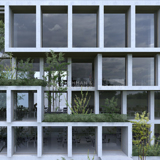Globally, the built environment accounts for approximately 40% of carbon emissions, making it a focal point for decarbonization efforts. Yet, much of the existing real estate stock, particularly office buildings, was constructed decades ago with little consideration for energy efficiency or sustainability. In cities like London, Paris, and New York, vast portfolios of aging structures are rapidly becoming functionally obsolete, unable to meet modern expectations for energy performance, user experience, and environmental compliance.
JLL’s report identifies over 86 million square meters of office space in the top eight markets as at risk of stranding—being rendered non-compliant with regulatory standards in the near term. For property owners, this represents not only a significant capital expenditure challenge but also a stark choice: adapt or face irrelevance in a competitive market.
Retrofitting for Sustainability
The transformation of outdated buildings begins with retrofitting, a process that entails upgrading structures to enhance energy performance and align with sustainability goals. Retrofitting isn’t just about meeting regulations; it also unlocks significant financial and operational benefits.
Whole-building retrofits can achieve energy use reductions of 40-65%, translating to annual savings of $31 per square meter. If implemented across global at-risk office stock, this could yield over $2.7 billion in energy savings annually. These projects not only lower operating costs but also make assets more attractive to tenants and investors increasingly focused on low-carbon buildings.
For example, in European cities with strict decarbonization mandates, such as Amsterdam and Berlin, retrofitted office buildings are commanding premium rents and higher occupancy rates. Beyond financial gains, these projects contribute to broader urban decarbonization goals, as cities often rely on the built environment to achieve their climate targets.
Adaptive Reuse: A Creative Solution
Not all aging buildings can be economically retrofitted for their original purpose. In such cases, adaptive reuse offers an alternative pathway to creating value. This approach involves repurposing structures for new uses, such as converting office buildings into residential spaces, hotels, or mixed-use developments
Lower Manhattan provides a compelling example of this trend. Long dominated by a 9-to-5 office culture, the area has seen a wave of conversions, adding thousands of residential units to its inventory. These projects have not only revitalized the neighborhood but also diversified its economic base, attracting retailers and recreational amenities that enhance its appeal.
Similarly, Tokyo’s Azabudai Hills redevelopment demonstrates how master-planned projects can balance preservation with innovation. By integrating residential, commercial, and green spaces, this former post office site now serves as a vibrant, multifunctional precinct.
The Shift from Spaces to Places
The post-pandemic era has accelerated a shift in how real estate is perceived and utilized. Traditional central business districts (CBDs), once synonymous with prestige and foot traffic, are losing ground to “destination” submarkets. These areas prioritize community, amenities, and a balanced mix of uses, creating environments where people want to live, work, and play.
Shibuya in Tokyo, 22@ in Barcelona, and Fulton Market in Chicago exemplify this shift. These areas have transformed into dynamic hubs by blending office, residential, and recreational spaces with cultural attractions. The result is not only higher demand but also a more resilient real estate ecosystem that thrives even as work patterns evolve.
Collaboration as a Catalyst
Tackling obsolescence at scale requires collaboration between public and private stakeholders. Governments are crucial in incentivizing redevelopment through policies and funding mechanisms, such as green bonds and tax credits for sustainable projects. Property owners, meanwhile, must align their portfolios with both market demands and regulatory frameworks, leveraging technologies like PropTech to enhance operational efficiency
Public-private partnerships have already shown promise in cities like London, where streetscape improvements and experiential spaces in office developments are reshaping the urban fabric. These initiatives highlight the potential for synergy between municipal goals and private-sector innovation.
The Financial Imperative
While addressing obsolescence requires substantial upfront investment, the long-term returns are compelling. Retrofitted and repurposed buildings often achieve higher occupancy rates, reduced energy costs, and greater tenant satisfaction. Moreover, assets that align with ESG (Environmental, Social, Governance) principles are increasingly favored by institutional investors, enhancing their marketability and valuation.
In Europe, real estate projects' alignment with the EU’s Green Deal and decarbonization targets is unlocking new financing opportunities. Sustainability-linked loans and green bonds are becoming essential tools for developers and owners aiming to future-proof their portfolios.
A Vision for the Future
The path forward lies in embracing obsolescence as an opportunity rather than a liability. Investing in sustainability, fostering creativity in adaptive reuse, and prioritizing placemaking, the real estate sector can transform outdated assets into valuable, future-ready properties.
As JLL’s report emphasizes, the choices made today will shape not only the financial performance of individual assets but also the broader urban landscapes they inhabit. In a world increasingly defined by change, those who innovate will lead the way in building cities that are resilient, inclusive, and sustainable.
By leveraging sustainability, adaptability, and collaboration, stakeholders can unlock new opportunities for growth while contributing to a more sustainable urban future.
Source:
JLL















